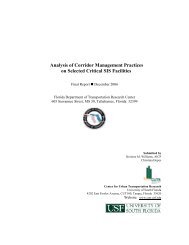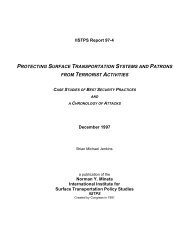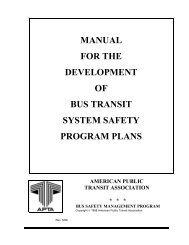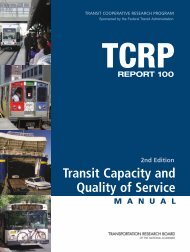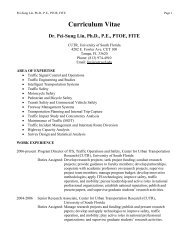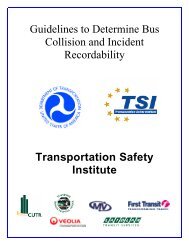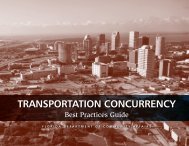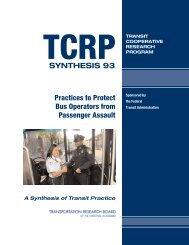a technical guide for conducting pedestrian safety assessments
a technical guide for conducting pedestrian safety assessments
a technical guide for conducting pedestrian safety assessments
You also want an ePaper? Increase the reach of your titles
YUMPU automatically turns print PDFs into web optimized ePapers that Google loves.
UNIVERSITY OF CALIFORNIA BERKELEY • INSTITUTE OF TRANSPORTATION STUDIES • TECHNOLOGY TRANSFER PROGRAM<br />
35<br />
TABLE 7: EXAMPLE PEDESTRIAN IMPROVEMENT MEASURES<br />
Measure Description Benefits Application<br />
Staggered<br />
Median<br />
Pedestrian<br />
Island<br />
This measure is similar to traditional<br />
median refuge islands; the<br />
only difference is that the crosswalks<br />
in the roadway are staggered<br />
such that a <strong>pedestrian</strong><br />
crosses half the street and then<br />
must walk towards traffic to<br />
reach the second half of the<br />
crosswalk. This measure must<br />
be designed <strong>for</strong> accessibility by<br />
including rails and truncated<br />
domes to direct sight-impaired<br />
<strong>pedestrian</strong>s along the path of<br />
travel.<br />
Benefits of this tool include<br />
an increase in<br />
the concentration of<br />
<strong>pedestrian</strong>s at a crossing<br />
and the provision<br />
of better traffic views<br />
<strong>for</strong> <strong>pedestrian</strong>s. Additionally,<br />
motorists are<br />
better able to see<br />
<strong>pedestrian</strong>s as they<br />
walk through the staggered<br />
refuge.<br />
Best used on multi-lane roads<br />
with obstructed <strong>pedestrian</strong> visibility<br />
or with off-set intersections<br />
Curb Extension<br />
Also known as a <strong>pedestrian</strong> bulbout,<br />
this traffic-calming measure<br />
is meant to slow traffic and increase<br />
driver awareness. It consists<br />
of an extension of the curb<br />
into the street, making the<br />
<strong>pedestrian</strong> space (sidewalk)<br />
wider.<br />
Curb extensions narrow<br />
the distance that a<br />
<strong>pedestrian</strong> has to cross<br />
and increases the sidewalk<br />
space on the corners.<br />
They also<br />
improve emergency vehicle<br />
access and make<br />
it difficult <strong>for</strong> drivers to<br />
turn illegally.<br />
Due to the high cost of installation,<br />
this tool would only be<br />
suitable on streets with high<br />
<strong>pedestrian</strong> activity, on-street<br />
parking, and infrequent (or no)<br />
curb-edge transit service. It is<br />
often used in combination with<br />
crosswalks or other markings.<br />
Reduced Curb<br />
Radii<br />
The radius of a curb can be reduced<br />
to require motorists to<br />
make a tighter turn.<br />
Shorter radii narrow<br />
the distance that<br />
<strong>pedestrian</strong>s have to<br />
cross; they also reduce<br />
traffic speeds and increase<br />
driver awareness<br />
(like curb<br />
extensions), but are<br />
less difficult and expensive<br />
to implement.<br />
This measure would be beneficial<br />
on streets with high <strong>pedestrian</strong><br />
activity, on-street parking,<br />
and no curb-edge transit service.<br />
It is more suitable <strong>for</strong><br />
wider roadways and roadways<br />
with low volumes of heavy truck<br />
traffic.<br />
Curb Ramps<br />
Curb ramps are sloped ramps<br />
that are constructed at the edge<br />
of a curb (normally at intersections)<br />
as a transition between the<br />
sidewalk and a crosswalk.<br />
Curb ramps provide<br />
easy access between<br />
the sidewalk and roadway<br />
<strong>for</strong> people using<br />
wheelchairs, strollers,<br />
walkers, crutches,<br />
handcarts, bicycles,<br />
and also <strong>for</strong> <strong>pedestrian</strong>s<br />
with mobility impairments<br />
who have<br />
trouble stepping up<br />
and down high curbs.<br />
Curb ramps must be installed<br />
at all intersections and midblock<br />
locations where <strong>pedestrian</strong><br />
crossings exist, as<br />
mandated by federal legislation<br />
(1973 Rehabilitation Act and<br />
1990 Americans with Disabilities<br />
Act). Where feasible, separate<br />
curb ramps <strong>for</strong> each<br />
crosswalk at an intersection<br />
should be provided rather than<br />
having a single ramp at a corner<br />
<strong>for</strong> both crosswalks.



